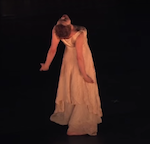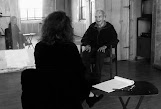first published in
EVERYTHING YOU SEE
VICKY SHICK with Nancy Dalva
DANSPACE PROJECT | APRIL 18 - 20, 2013
The next installment of choreographer Vicky Shick’s ongoing
collaboration with artist Barbara Kirkpatrick, sound designer Elise
Kermani, and lighting designer Carol Mullins unfolds this month at
Danspace Project. A dancer’s dancer, a teacher’s teacher, this lovely
and beloved woman is so unfailingly modest it comes as an astonishing
contradiction—even in the theatrical universe of introverted
extroverts—that she goes out on a stage and holds the room in suspended
animation, captive to her reticent elegance, her giraffe ways, her
silvery, organza movement. Hers is work that is the opposite of epic:
economical, allusive, elliptical; given to fleeting apprehensions,
elusive epiphanies. And so, we tried to pin her down.
Nancy Dalva (Rail): If we think of your work as a
series of short stories—as I do—where is this new one in relation to
your recent work at the Kitchen? And La MaMa?
Vicky Shick: The nature of this dance is much more
chaotic and that is unsettling. Not the individual little parts but the
flow, the transitions, the connections—the whole. Usually the unfolding
of an idiosyncratic logic grounds me; it’s harder to find now, the
reason being that I’m constructing a dance with two fronts and audiences
sitting on two sides. So in a way, there are two dances being performed
simultaneously, while these two dances are also one big dance.
Rail: I know you say you don't work in narrative, but there is always to me the sense of a subliminal or suggested narrative.
Shick: Yes, I think my tendency is to have that hint
of narrative, as I did in those two pieces you mentioned. This time,
I’ve had to let that go and try for something more abstract because of
the two fronts and the dancers switching sides. It’s unwieldy and messy,
which I don’t necessarily mind, but the lust for that “hint” is,
perhaps, inexplicably creeping in and interfering with needing to let it
go.
Rail: Who is in it?
Shick: The dancers are Jodi Bender, Donna Costello,
Olsi Gjeci, Lily Gold, Jon Kinzel, Marilyn Maywald, Heather Olson, Wendy
Perron, Laurel Tentindo, and me. Some of them I met in classes I’ve
taught, some I’ve danced with before, and some I’ve had very long
histories with.
Rail: How are you making the piece, working with these dancers? Can you get them in the room all at once when you need to?
Shick: It is almost impossible to get them in one room at one time—and I haven’t yet. In fact, one person lives in California. Even the scheduling is daunting.
I love working one on one or with a duet. I’m very interested in individual phrasing and highlighting imperceptible details. I have a notion that I don’t want it to look like coined dance movement, and yet I am drawn to it being very physically articulate and specific. I’m excited by individuality, “realness,” and intimacy, and want to somehow find a way to accent that. It’s definitely easier to locate that in a solo or duet. I would love my dance to look like film or real life.
Shick: It is almost impossible to get them in one room at one time—and I haven’t yet. In fact, one person lives in California. Even the scheduling is daunting.
I love working one on one or with a duet. I’m very interested in individual phrasing and highlighting imperceptible details. I have a notion that I don’t want it to look like coined dance movement, and yet I am drawn to it being very physically articulate and specific. I’m excited by individuality, “realness,” and intimacy, and want to somehow find a way to accent that. It’s definitely easier to locate that in a solo or duet. I would love my dance to look like film or real life.
Rail: Where does a dance start for you? A movement, a notion, an image...
Shick: I most often start in a studio by myself,
trying to find a movement vocabulary. I never start with an idea.
Sometimes I do have an image that I know I’d like to include, but I
always know it’s just a little spot, a little decoration, not the nugget
that defines the whole. Again, I love working with individuals and with
duos; it’s how I feel I can begin to define a world, a progression and
an intimate relationship. I actually have infinite patience for these
situations and find great value in the tiniest changes we might make.
Rail: I see a lot of dances that call up universal
emotions, some quite powerfully. But only yours seem to show me how I
feel, I mean particularly, acutely, me. I don’t know what is
going on, but I know the feeling behind whatever is going on. You’ve
made me think that it is possible to “read between the moves” of
choreography the way one “reads between the lines” of something written.
Shick: I hesitate to try for emotion because I know
that’s not how to achieve it. However, I would love for people to feel
something. Earlier this year, I fantasized making a dance and calling it
“Sadness,” but I realized I didn’t have the courage to do it, to take
on something so huge, and, in some deep way, knew that it wouldn’t be
for me—someone nurtured in the age of abstract minimalism. I wish I
could create a tragedy, like in some slow devastating Eastern European
film, but I have to settle for some vague nuances that might point
toward it.
Rail: You danced with Trisha Brown for six years.
You have made your own work for decades. You are a cherished teacher
here in New York, and in festivals, in workshops, at universities, and
in your own hometown, Budapest. You perform in other people's work as a
dancer—with choreographers including Yoshiko Chuma, Deborah Hay, Iréne
Hultman, Risa Jaroslow, Daniel Lepkoff, Barbara Mahler, Juliette Mapp,
Wendy Perron, Stephen Petronio, Susan Rethorst, Sally Silver, and Sara
Rudner. You are so gentle about it all, but yet your own eye is so keen,
so discerning. It seems to have inherent difficulties on so many
levels, pragmatic, practical… And yet. Vicky, are you happy in your
work? Is there some underpinning of pleasure that informs us, as we
watch you? Or of sorrow? As a dancer, you are somehow affectionate with
us, your public, and yielding to your dancing partners. What are you
feeling in there?
Shick: I love dance; I love dancers; I love trying
to make a dance and spending tremendous amounts of time in a studio with
the people with whom I am working. I feel unbelievably lucky to have
danced with many people—some of my dearest friends—and, right now, to be
with these particular nine people working, laughing, struggling,
learning, snacking. But I am most drawn to the rigor of practicing a
physicality—defining and refining it over and over again, and then some
more. And for this, too, I have a lot of patience, which, however,
results in very slow progress….
©Nancy Dalva 2013



















